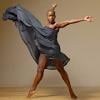
Chafin Seymour and I talked on the phone last month, after the quarantine began but before the smoke streamed in. Seymour, 30, teaches dance and choreography at San José State University, where he’s an assistant professor. He was working at home, a little two-bedroom house with a garden just a bike ride from campus, preparing for the new semester, where he would teach his dance students on Zoom and in classes newly reduced by half and moved out of the studio into the open air.
It is not my wont to write about friends or their offspring. It’s just not the done thing. But curiosity, and occasional engaging glimpses of his work, made me do it.
I met Chafin when he was 4. His parents, Gene Seymour and Marie Nahikian, are old friends from New York City. Marie was a political activist; Gene was covering culture—including film, TV, and jazz — for New York Newsday, where I covered dance.
Chafin and his parents joined me one December afternoon as I reviewed a child-size performance of The Nutcracker by Diana Byer’s New York Theater Ballet. Chafin stood in front of his second-row seat for the entire performance, swaying to the Tchaikovsky, his big brown eyes riveted on the stage. Soon after, he began taking dance classes. Auntie Janice had helped create a monster.
And it was good. “My whole childhood was spent around the performing arts,” he remembered. When he was 6, he began studying modern dance with Ellen Robbins — still one of the most-respected teachers in New York — at Dance Theater Workshop. She introduced him to the art and the craft of choreography. “My first composition for an audience was made for her year-end concert,” he recalled. “It was titled Boy in the Rice Fields and was set to the music of Sweet Honey in the Rock.”

Chafin Seymour kept dancing as he grew into his teens. After graduating from Packer Collegiate Institute in Brooklyn, he won a full dance scholarship to Ohio State University. There he started his own dance group, seymour::dancecollective (“no spaces or capitals, and the double colon is intentional,” he specified the other day by email). After a break in Brooklyn, when he taught modern dance at Gina Gibney’s studio, made new work for his collective and tended bar, he went back to school, earning a master’s in dance with distinction from the University of Iowa.
Seymour now faced two career paths. “Which lottery would I rather play, the lottery of grants and clout, or the other lottery, which is academia?” he recalled. “Both were unpredictable, but I felt there were better chances in academia.” He spent most of 2018 looking everywhere for a job. Finally, he got one.
In August 2019, he and his girlfriend, dancer Chelsea Escher, who also works in physical therapy, landed at San José State University. A year in, Seymour remains a New Yorker to his core. “I kind of feel like I escaped at the last minute, but missed out on what it feels like to experience New York in the pandemic.”
In San José State’s music and dance department, he thinks he chose wisely. “I feel very lucky to be in a department that is growing, shifting and changing, and widening its dance commitment.” He credits Professor Heather Cooper, who directs the dance division within SJSU’s School of Music and Dance, with reformatting and raising the dance program’s profile. He also credits her with giving him the confidence to go after the new teaching position she’d created.
SJSU’s dance division has two full-time professors and six to seven adjuncts, whose backgrounds embrace several strains of dance. The faculty include noted Bay Area modern choreographer Mark Foehringer, and Diane Frank, who studied and taught with Merce Cunningham. Guests have included choreographers like Kyle Abraham and Doug Varone, among many others. “It’s great to interact with a department with a strong ballet faculty,” said Seymour, “and a pool of really accomplished scholars and writers about dance.” He uses writing to ground his dance practice beyond the studio. “It’s not just a piece on the stage — and it can’t be, especially now.”
Since the lockdown, his studio classes have been halved, from 10 down to 5 students. The 80 dance majors each have two live and two online classes per week. Seymour teaches outdoors on hard surfaces — “hip-hop, not floorwork” — and holds online dance classes for some 200 to 300 non-majors, with “lots of floorwork and little traveling,” keeping in mind that their range of motion may be constrained to their bedroom or the space immediately around their bodies. So far, so good, he said, as the new school year began, but “our plans have been shifting constantly since March,” as the department works through contingencies and red tape and the possibility that “we might go back into SIP at any moment in time.”

San José’s dance department has strong ties to the modern master José Limón, and by coincidence, so does Chafin Seymour. A Limón dancer, David Glista, is a friend and collaborator in Seymour’s company. Limón’s then artistic director, Colin Connor, attended some performances and invited Seymour to create a co-commission for the American Dance Festival, where it’s set to premiere, hopefully, next summer.
The dance program at SJSU was founded by Gary Masters, a former artist in Limón Dance and the current director and co-founder of sjDANCEco. “Limón technique is still a foundational element to our contemporary dance curriculum,” currently carried on by faculty member and former Limón dancer Raphael Boumaila.
Limón (1908–1972), was born in Culiacan, Mexico, and moved with his family to Los Angeles in 1915 and then in the ’20s to New York, where he studied Humphrey-Weidman technique. In 1946 he launched his own company, and asked Humphrey to lead it. Limón’s technique is sometimes shorthanded as fall and recovery, but it also invokes emotion through the dancers’ rangy dynamism.
Limón’s heritage ties in well with the San José community. SJSU is 60 percent nonwhite. “Because of where we are, it’s mostly LatinX, Vietnamese, Korean. African Americans are less than two percent,” Seymour said. His father is Black and his mother is white. He identifies as Black, and looks white. He realizes that “in terms of how I interact with the world, I will not experience the kind of violence that my peers do.”
To the question of whether nonwhite dancers ought to be trained in ballet, he answers yes. “If you really want to dance, you have to learn ballet as a basis of all dance,” he said, adding that it’s necessary to learn “the language of the oppressor. I don’t aspire to ballet, but I teach it as a rigorous performative practice. That training is just as valid as any other form, given the structure of society, the white patriarchy and capitalism.
“It’s really important,” he added. “Especially with young children. If they come into contact with ballet, it’s as valuable as learning English is valuable. It’s dangerous if we don’t recognize positions of power and how we fit into that.” A wide-ranging knowledge of the art form, he added, is empowering for rising dancers encountering funders and presenters in the arts community who feel that “being Black or queer is not what we had in mind,” Seymour said, his gentle tone only mildly sarcastic. A broader awareness of what’s possible, he said, can be the beginning of a “Yes, and ...” conversation rather than the end of one.
For his own dancemaking, Seymour has an array of inspirations, a good thing. Hired on a tenure track, he must make new work to move up, a kinesthetic publish or perish. He works with postmodern release technique, but also with gravity and weight, two aspects of the Judson Dance Theater. He’s also inspired by David Dorfman’s athleticism and physicality, “which has as deep and rich a history as ballet does, but is not as well documented.” That creativity and its documentation, he said, is where “Shift has to happen.” He feels good about his dance department’s culture, “the effort, the focus, the attitude. We’re aggressive in terms of the work we’re asking the students to do.”
Seymour decided on his career during college, when he was a mentor and counselor at Bates College’s summer workshop for young dancers from all over the country. He experienced a love of the community there. “I had this moment of knowing that dance was it, and what I wanted my primary career to be.” Now “it’s just a matter of trying to carve out a little place for myself.”




